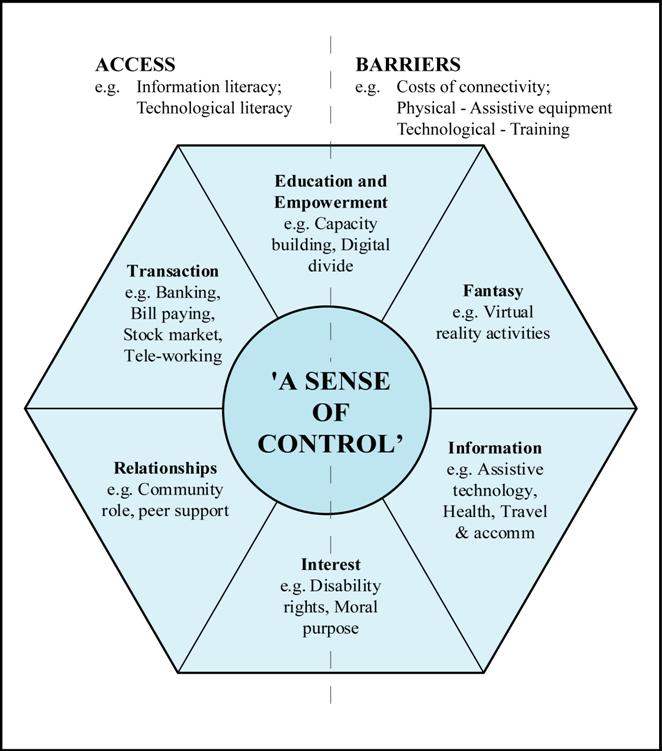http://www.informationr.net/ir/11-3/paper253.html
Tilley, C.M., Bruce, C.S., Hallam, G. & Hills, A.P. (2006) "A model for the development of virtual communities for people with long-term, severe physical disabilities" Information Research, 11(3) paper 253 [Available at http://InformationR.net/ir/11-3/paper253.html]
A model of virtual communities for persons with disabilities:
a mf

Figure 1: The six types of E-Communities that constitute a framework or the cornerstones for a Virtual Community model for persons with long-term physical disabilities. (Note that Access and Barriers relate to all situations - not just those depicted left and right of the diagram.)
The model for a virtual community for persons with long-term, severe physical disabilities that emerged was a meld of six types of electronic communities (see Figure 1). The types of e-communities or sets of well-developed discreet categories (e.g., themes and concepts) that the data from this study revealed were the following, depending on the types of consumer needs they met:
- education;
- fantasy-oriented;
- information-oriented;
- interest-oriented;
- relationship-oriented; andtransaction-oriented
- The e-communities or categories are systematically interrelated through statements of relationship to form the theoretical framework that explains the relevant social phenomenon, although they are presented here as separate units for the sake of graphical representation. The statements of relationship between these categories allows for objectification and explains who (relationship), what (information), when (interest), where (transaction), why (education and empowerment), how (fantasy), and with what consequences (access and barriers) an event occurs. For the model to be truly generalisable and transformational, all six types of virtual communities needed to be established as potential portals to be developed for persons with disabilities. It is also possible that the model for a virtual community for persons with long-term severe physical disabilities, in fact, meets several, if not all, of the above needs, purposes or orientations simultaneously. In the end, it must be emphasised that if any one of these types of e-communities were ignored, then the full virtual community experience will not be available to persons with disabilities.
FINDINGS:
| Phenomenon: A sense of control | |||
|---|---|---|---|
| Categories | Properties | Dimensions | Sub-categories |
| Education | e-learning, capacity building, information literacy, technologically literate | Digital divide, confidence, information exchange, well-being, motivation, skills | Empowerment, engagement, equality, life-long learning, shared vision |
| Fantasy | Virtual activities, virtual community, virtual family, virtual living, virtual reality | Access, anonymity, communicate, interact, participate | Double-edged sword of technology, barrier-free, recreation |
| Information | e-searching, equality, virtual communities | Discussion groups, education, entertainment, legislation, leisure | Access, choice |
| Interest | Disability rights, leadership, moral purpose, social justice | Access, equity, independence, mobility, participation, values-driven | Assistive technology, civil society, inclusion, self-determination, vision, voice |
| Relationship | Community role, peer support, systemic advocacy | Collective experience, shared knowledge, self-esteem, valued role | Acceptance, identity, privacy, social networks |
| Transaction | e-commerce, employment | Investments, shopping, ordering, bill paying | Tele-working, tele-marketing. |
This article brings to my attention the concept of a "virtual community" and what it can bring to those with a long-term disability. I would like to look into this idea further and see some of the additional benefits and also some options that may be evadable for someone like Nathan.
I have also looked into some research into different theories related to physical disability and am anxious to get the articles from the library. The theory that I would like to explore is the "theory of planned behavior" related to college students with disabilities.
| Social Psychology of Education: How well does the Theory of Planned Behavior predict graduation among college and university students with disabilities | Fichten, C. S., Nguyen, M. N., Amsel, R., Jorgensen, S., Budd, J., Jorgensen, M., Asuncion, J., & Ba |
Are there theories that can help me better understand what a student like Nathan is going through as a college student with a disability? What are the struggles he faces, how does he cope on a day to day basis? These are all areas that I want to explore for next week's entry.
No comments:
Post a Comment